February 1989 lunar eclipse
| Total eclipse | |||||||||||||||||
 The Moon's hourly motion shown right to left | |||||||||||||||||
| Date | February 20, 1989 | ||||||||||||||||
|---|---|---|---|---|---|---|---|---|---|---|---|---|---|---|---|---|---|
| Gamma | 0.2935 | ||||||||||||||||
| Magnitude | 1.2747 | ||||||||||||||||
| Saros cycle | 123 (51 of 73) | ||||||||||||||||
| Totality | 78 minutes, 31 seconds | ||||||||||||||||
| Partiality | 223 minutes, 7 seconds | ||||||||||||||||
| Penumbral | 367 minutes, 40 seconds | ||||||||||||||||
| |||||||||||||||||
A total lunar eclipse occurred at the Moon’s descending node of orbit on Monday, February 20, 1989,[1] with an umbral magnitude of 1.2747. A lunar eclipse occurs when the Moon moves into the Earth's shadow, causing the Moon to be darkened. A total lunar eclipse occurs when the Moon's near side entirely passes into the Earth's umbral shadow. Unlike a solar eclipse, which can only be viewed from a relatively small area of the world, a lunar eclipse may be viewed from anywhere on the night side of Earth. A total lunar eclipse can last up to nearly two hours, while a total solar eclipse lasts only a few minutes at any given place, because the Moon's shadow is smaller. Occurring about 3 days before apogee (on February 23, 1989, at 14:30 UTC), the Moon's apparent diameter was smaller.[2]
Visibility
The eclipse was completely visible over the eastern half of Asia and Australia, seen rising over much of Africa, Europe, and west, central, and south Asia and setting over much of North America and the eastern Pacific Ocean.[3]
 
|
Eclipse details
Shown below is a table displaying details about this particular solar eclipse. It describes various parameters pertaining to this eclipse.[4]
| Parameter | Value |
|---|---|
| Penumbral Magnitude | 2.36514 |
| Umbral Magnitude | 1.27467 |
| Gamma | 0.29347 |
| Sun Right Ascension | 22h15m55.3s |
| Sun Declination | -10°46'12.9" |
| Sun Semi-Diameter | 16'10.4" |
| Sun Equatorial Horizontal Parallax | 08.9" |
| Moon Right Ascension | 10h16m24.6s |
| Moon Declination | +11°00'28.8" |
| Moon Semi-Diameter | 14'49.9" |
| Moon Equatorial Horizontal Parallax | 0°54'25.9" |
| ΔT | 56.4 s |
Eclipse season
This eclipse is part of an eclipse season, a period, roughly every six months, when eclipses occur. Only two (or occasionally three) eclipse seasons occur each year, and each season lasts about 35 days and repeats just short of six months (173 days) later; thus two full eclipse seasons always occur each year. Either two or three eclipses happen each eclipse season. In the sequence below, each eclipse is separated by a fortnight.
| February 20 Descending node (full moon) |
March 7 Ascending node (new moon) |
|---|---|
 |

|
| Total lunar eclipse Lunar Saros 123 |
Partial solar eclipse Solar Saros 149 |
Related eclipses
Eclipses in 1989
- A total lunar eclipse on February 20.
- A partial solar eclipse on March 7.
- A total lunar eclipse on August 17.
- A partial solar eclipse on August 31.
Metonic
- Preceded by: Lunar eclipse of May 4, 1985
- Followed by: Lunar eclipse of December 9, 1992
Tzolkinex
- Preceded by: Lunar eclipse of January 9, 1982
- Followed by: Lunar eclipse of April 4, 1996
Half-Saros
- Preceded by: Solar eclipse of February 16, 1980
- Followed by: Solar eclipse of February 26, 1998
Tritos
- Preceded by: Lunar eclipse of March 24, 1978
- Followed by: Lunar eclipse of January 21, 2000
Lunar Saros 123
- Preceded by: Lunar eclipse of February 10, 1971
- Followed by: Lunar eclipse of March 3, 2007
Inex
- Preceded by: Lunar eclipse of March 13, 1960
- Followed by: Lunar eclipse of January 31, 2018
Triad
- Preceded by: Lunar eclipse of April 22, 1902
- Followed by: Lunar eclipse of December 22, 2075
Lunar eclipses of 1988–1991
This eclipse is a member of a semester series. An eclipse in a semester series of lunar eclipses repeats approximately every 177 days and 4 hours (a semester) at alternating nodes of the Moon's orbit.[5]
The lunar eclipses on June 27, 1991 (penumbral) and December 21, 1991 (partial) occur in the next lunar year eclipse set.
| Lunar eclipse series sets from 1988 to 1991 | ||||||||
|---|---|---|---|---|---|---|---|---|
| Descending node | Ascending node | |||||||
| Saros | Date Viewing |
Type Chart |
Gamma | Saros | Date Viewing |
Type Chart |
Gamma | |
| 113 | 1988 Mar 03
|
Penumbral
|
0.9886 | 118 | 1988 Aug 27
|
Partial
|
−0.8682 | |
| 123 | 1989 Feb 20
|
Total 
|
0.2935 | 128 | 1989 Aug 17
|
Total
|
−0.1491 | |
| 133 | 1990 Feb 09
|
Total
|
−0.4148 | 138 | 1990 Aug 06
|
Partial
|
0.6374 | |
| 143 | 1991 Jan 30
|
Penumbral
|
−1.0752 | 148 | 1991 Jul 26
|
Penumbral
|
1.4370 | |
Metonic series
This is the third of five Metonic lunar eclipses.
The Metonic cycle repeats nearly exactly every 19 years and represents a Saros cycle plus one lunar year. Because it occurs on the same calendar date, the Earth's shadow will in nearly the same location relative to the background stars.
| Descending node | Ascending node | |||||
|---|---|---|---|---|---|---|
| Saros | Date | Type | Saros | Date | Type | |
| 103 | 1951 Feb 21.88 | Penumbral | 108 | 1951 Aug 17.13 | Penumbral | |

|

| |||||
| 113 | 1970 Feb 21.35 | Partial | 118 | 1970 Aug 17.14 | Partial | |
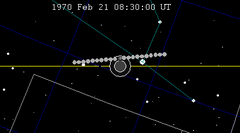
|
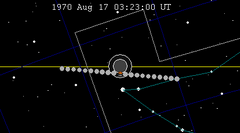
| |||||
| 123 | 1989 Feb 20.64 | Total | 128 | 1989 Aug 17.13 | Total | |
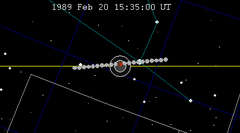
|
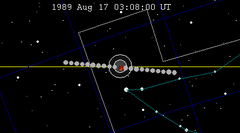
| |||||
| 133 | 2008 Feb 21.14 | Total | 138 | 2008 Aug 16.88 | Partial | |

|
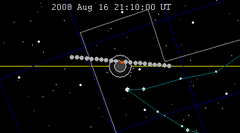
| |||||
| 143 | 2027 Feb 20.96 | Penumbral | 148 | 2027 Aug 17.30 | Penumbral | |
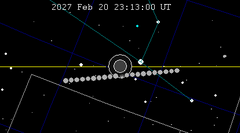
|
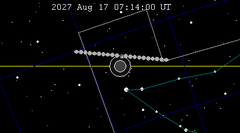
| |||||
Saros 123
This eclipse is a part of Saros series 123, repeating every 18 years, 11 days, and containing 72 events. The series started with a penumbral lunar eclipse on August 16, 1087. It contains partial eclipses from May 2, 1520 through July 6, 1610; total eclipses from July 16, 1628 through April 4, 2061; and a second set of partial eclipses from April 16, 2079 through July 2, 2205. The series ends at member 72 as a penumbral eclipse on October 8, 2367.
The longest duration of totality was produced by member 37 at 105 minutes, 58 seconds on September 20, 1736. All eclipses in this series occur at the Moon’s descending node of orbit.[6]
| Greatest | First | |||
|---|---|---|---|---|
| The greatest eclipse of the series occurred on 1736 Sep 20, lasting 105 minutes, 58 seconds.[7] | Penumbral | Partial | Total | Central |
| 1087 Aug 16 |
1520 May 02 |
1628 Jul 16 |
1682 Aug 18 | |
| Last | ||||
| Central | Total | Partial | Penumbral | |
1953 Jan 29
|
2061 Apr 04 |
2205 Jul 02 |
2367 Oct 08 | |
Eclipses are tabulated in three columns; every third eclipse in the same column is one exeligmos apart, so they all cast shadows over approximately the same parts of the Earth.
| Series members 41–62 occur between 1801 and 2200: | |||||
|---|---|---|---|---|---|
| 41 | 42 | 43 | |||
| 1808 Nov 03 | 1826 Nov 14 | 1844 Nov 24 | |||
| 44 | 45 | 46 | |||
| 1862 Dec 06 | 1880 Dec 16 | 1898 Dec 27 | |||
| 47 | 48 | 49 | |||
| 1917 Jan 08 | 1935 Jan 19 | 1953 Jan 29 | |||

|

|

|

|

|

|
| 50 | 51 | 52 | |||
| 1971 Feb 10 | 1989 Feb 20 | 2007 Mar 03 | |||

|

|

|

|

|

|
| 53 | 54 | 55 | |||
| 2025 Mar 14 | 2043 Mar 25 | 2061 Apr 04 | |||

|

|

|

|
||
| 56 | 57 | 58 | |||
| 2079 Apr 16 | 2097 Apr 26 | 2115 May 08 | |||
| 59 | 60 | 61 | |||
| 2133 May 19 | 2151 May 30 | 2169 Jun 09 | |||
| 62 | |||||
| 2187 Jun 20 | |||||
Tritos series
The tritos series repeats 31 days short of 11 years at alternating nodes. Sequential events have incremental Saros cycle indices.
This series produces 20 total eclipses between April 24, 1967 and August 11, 2185, only being partial on November 19, 2021.
| Tritos eclipse series (subset 1901–2087) | ||||||
|---|---|---|---|---|---|---|
| Descending node | Ascending node | |||||
| Saros | Date Viewing |
Type chart |
Saros | Date Viewing |
Type chart | |
| 115 | 1901 Oct 27
|
Partial
|
116 | 1912 Sep 26
|
Partial
| |
| 117 | 1923 Aug 26
|
Partial
|
118 | 1934 Jul 26
|
Partial
| |
| 119 | 1945 Jun 25
|
Partial
|
120 | 1956 May 24
|
Partial
| |
| 121 | 1967 Apr 24
|
Total
|
122 | 1978 Mar 24
|
Total
| |
| 123 | 1989 Feb 20
|
Total
|
124 | 2000 Jan 21
|
Total
| |
| 125 | 2010 Dec 21
|
Total
|
126 | 2021 Nov 19
|
Partial
| |
| 127 | 2032 Oct 18
|
Total
|
128 | 2043 Sep 19
|
Total
| |
| 129 | 2054 Aug 18
|
Total
|
130 | 2065 Jul 17
|
Total
| |
| 131 | 2076 Jun 17
|
Total
|
132 | 2087 May 17
|
Total
| |
| 133 | 2098 Apr 15
|
Total
| ||||
Half-Saros cycle
A lunar eclipse will be preceded and followed by solar eclipses by 9 years and 5.5 days (a half saros).[8] This lunar eclipse is related to two total solar eclipses of Solar Saros 130.
| February 16, 1980 | February 26, 1998 |
|---|---|

|

|
See also
Notes
- ^ "February 20–21, 1989 Total Lunar Eclipse (Blood Moon)". timeanddate. Retrieved 7 January 2025.
- ^ "Moon Distances for London, United Kingdom, England". timeanddate. Retrieved 7 January 2025.
- ^ "Total Lunar Eclipse of 1989 Feb 20" (PDF). NASA. Retrieved 7 January 2025.
- ^ "Total Lunar Eclipse of 1989 Feb 20". EclipseWise.com. Retrieved 7 January 2025.
- ^ van Gent, R.H. "Solar- and Lunar-Eclipse Predictions from Antiquity to the Present". A Catalogue of Eclipse Cycles. Utrecht University. Retrieved 6 October 2018.
- ^ "NASA - Catalog of Lunar Eclipses of Saros 123". eclipse.gsfc.nasa.gov.
- ^ Listing of Eclipses of series 123
- ^ Mathematical Astronomy Morsels, Jean Meeus, p.110, Chapter 18, The half-saros
External links
- 1989 Feb 20 chart Eclipse Predictions by Fred Espenak, NASA/GSFC



